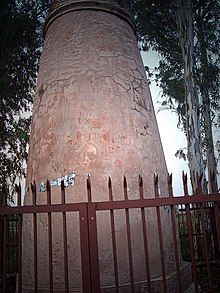
Back فاتح بور سيكري Arabic فتحبور سيكرى ARZ Fatehpur Sikri AST Fatehpur-Sikri Azerbaijani Фатехпур Сикри Bulgarian फतेहपुर सीकरी Bihari ফতেপুর সিকরি Bengali/Bangla ফতেহপুর সিক্রি BPY Fatehpur Sikri Catalan Fatehpur Sīkri CEB
Fatehpur Sikri | |
|---|---|
Town | |
 Buland Darwaza, the 54-metre-high (177 ft) entrance to Fatehpur Sikri's Jama Masjid | |
| Coordinates: 27°05′28″N 77°39′40″E / 27.091°N 77.661°E | |
| Country | India |
| State | Uttar Pradesh |
| District | Agra |
| Founded by | Akbar |
| Population | |
| • Total | 32,905 |
| Language | |
| • Official | Hindi[2] |
| • Additional official | Urdu[2] |
| Time zone | UTC+5:30 (IST) |
| Vehicle registration | UP-80 |
| Official name | Fatehpur Sikri |
| Criteria | Cultural: ii, iii, iv |
| Reference | 255 |
| Inscription | 1986 (10th Session) |

Fatehpur Sikri (Hindi: [ˈfətɛɦpʊɾ ˈsiːkɾiː]) is a town in the Agra District of Uttar Pradesh, India. Situated 35.7 kilometres (22.2 mi) from the district headquarters of Agra,[3] Fatehpur Sikri itself was founded as the capital of the Mughal Empire in 1571 by Emperor Akbar, serving this role from 1571 to 1585, when Akbar abandoned it due to a campaign in Punjab and was later completely abandoned in 1610.[4]
The name of the city is derived from the village called Sikri which previously occupied the location. An Archaeological Survey of India (ASI) excavation from 1999 to 2000 indicated that there was housing, temples and commercial centres here before Akbar built his capital. The region was settled by Sungas following their expansion. It was controlled by Sakarwar Rajputs from the 7th to 16th century CE until the Battle of Khanwa (1527).[5]
The khanqah of Sheikh Salim Chishti existed earlier at this place. Akbar's son, Jahangir, was born in the village of Sikri to his favourite wife Mariam-uz-Zamani in 1569,[6] and, in that year, Akbar began construction of a religious compound to commemorate the Sheikh who had predicted the birth. After Jahangir's second birthday, he began the construction of a walled city and imperial palace here. The city came to be known as Fatehpur Sikri, the "City of Victory", after Akbar's victorious Gujarat campaign in 1573.
After occupying Agra in 1803, the East India Company established an administrative centre here and it remained so until 1850. In 1815, the Marquess of Hastings ordered the repair of monuments at Sikri.
Because of its historical importance as the capital of the Mughal Empire and its outstanding architecture, Fatehpur Sikri was awarded the status of UNESCO World Heritage Site in 1986.[7][8]
- ^ Cite error: The named reference
Census2011Govwas invoked but never defined (see the help page). - ^ a b "52nd Report of the Commissioner for Linguistic Minorities in India" (PDF). nclm.nic.in. Ministry of Minority Affairs. Archived from the original (PDF) on 25 May 2017. Retrieved 26 December 2018.
- ^ "Fatehpur Sikri". www.tajmahal.gov.in. Archived from the original on 8 March 2022. Retrieved 8 March 2022.
- ^ Andrew Petersen (11 March 2002). Dictionary of Islamic Architecture. Routlegde. p. 82. ISBN 9781134613656.
- ^ Patil, Devendrakumar Rajaram (1963). The Antiquarian Remains in Bihar. Kashi Prasad Jayaswal Research Institute. p. 75.
- ^ Hindu Shah, Muhammad Qasim. Gulshan-I-Ibrahimi. p. 223.
- ^ "Fatehpur Sikri". UNESCO World Heritage Centre. Archived from the original on 15 February 2022. Retrieved 15 February 2022.
- ^ "30 Years as World Heritage Site: Fatehpur Sikri". 22 March 2016. Archived from the original on 13 January 2022. Retrieved 13 January 2022.
© MMXXIII Rich X Search. We shall prevail. All rights reserved. Rich X Search

